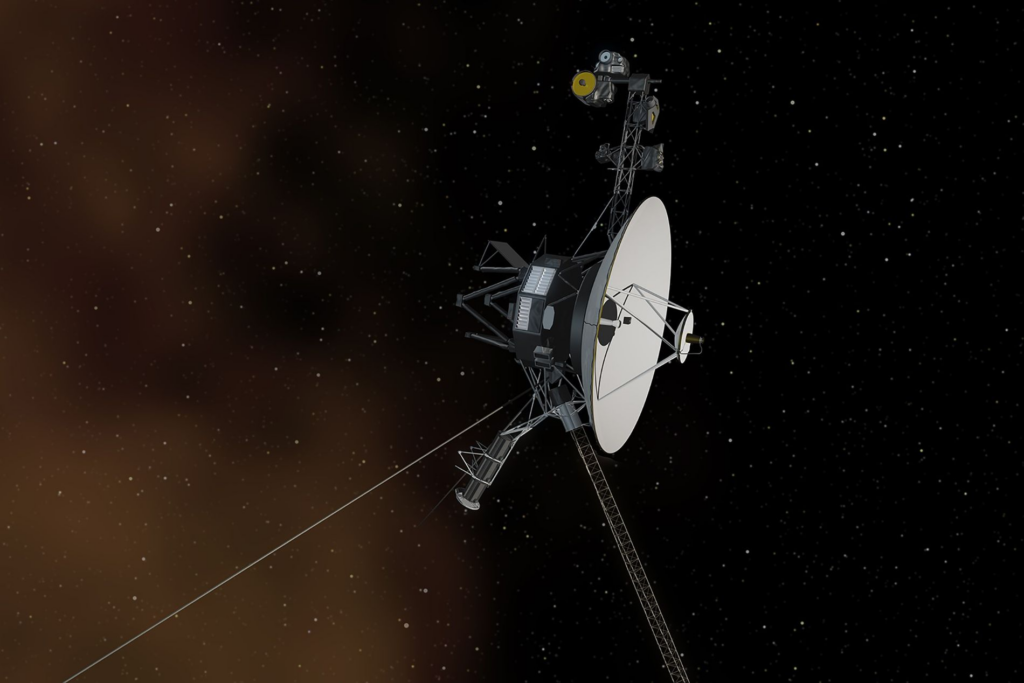La Voyager 1, la sonda más alejada de la Tierra, ha vuelto a captar la atención mundial tras enviar señales a la Tierra después de cinco meses de silencio. Este acontecimiento marca un hito en la historia de la exploración espacial y demuestra la capacidad de la humanidad para mantener la comunicación con una nave que se encuentra a unos 24.000 millones de kilómetros de distancia.
A Triumphant Return
After a period of uncertainty, NASA engineers received decipherable data from Voyager 1 thanks to a creative solution to a communication problem that had plagued the probe since November 2023. The signal received on April 20 confirmed that the probe is healthy and its systems are functioning properly.
Innovation and Perseverance
Voyager 1’s recent recovery is a testament to innovation and perseverance. NASA engineers managed to overcome the challenge of distance and time, using an ingenious trial-and-error process to solve the communication problem. The probe, which carries an audible message for possible extraterrestrial encounters, remains the farthest human-made object from Earth.
The Voyager 1 Odyssey
Voyager 1 was launched on September 5, 1977, with the original mission to visit Jupiter and Saturn. It was the first probe to provide detailed images of the satellites of these planets and has continued its journey into interstellar space. In 2012, the probe left the heliopause behind, becoming the first to reach interstellar space.
Looking to the future
With this new chapter in its history, Voyager 1 continues its mission of more than four decades, sending back valuable information that could change our understanding of the universe. The scientific community and space enthusiasts look forward to more discoveries from this tireless explorer of the cosmos.

Problems millions of kilometers away
In November 2023 Voyager 1 stopped communicating with Earth for unknown reasons, the mission team attempted to reboot the spacecraft’s computer in different ways and learn more about the problem that was causing the space explorer to no longer send signals to Earth, so the team sent a command called “poke” to Voyager 1 on March 1 to have the flight data system run different software sequences in hopes of figuring out what was causing the failure. Shortly thereafter, on March 3, the team noticed that activity in one part of the flight data system stood out from the rest of the garbled data. Although the signal was not in the format the Voyager team is used to when the flight data system is working as expected, an engineer from NASA’s Deep Space Network was able to decipher the signal.
The Deep Space Network enables missions to track, send commands and receive science data from distant spacecraft. With a total of 14 antennas in operation, the network currently supports more than 40 missions and is expected to support another 40 to be launched in the coming years. Antennas for the Deep Space Network were previously placed in complexes located in the United States, Australia and Madrid (Goldstone in California, Canberra in Australia and Robledo in Madrid), the Spanish complex is the only one in the world with 6 operational antennas. Each complex has a 70-meter antenna and 36-meter antennas.
Upon investigating the readout, the team determined the cause of the problem: 3% of the system’s memory was corrupted. A single chip responsible for storing part of the system memory, including part of the computer software code, is not functioning properly. The cause of the failure is unfortunately unknown, but the loss of the chip rendered Voyager 1’s science and engineering data unusable.
Interstellar exploration continues
In the coming weeks, the team will continue to relocate other affected parts of the system’s software, including those responsible for returning the valuable science data Voyager 1 is collecting.
Originally designed to last five years, Voyager 1 and its twin, Voyager 2, were launched in 1977 and are the longest operating spacecraft in history. Their exceptionally long lifetimes mean that both spacecraft have provided additional knowledge about our solar system and beyond after reaching their preliminary goals of flying over Jupiter, Saturn, Uranus and Neptune decades ago.
The probes are currently venturing through unexplored cosmic territory along the outer reaches of the solar system. Both are in interstellar space and are the only spacecraft that have operated beyond the heliosphere, the bubble of magnetic fields and particles from the sun that extends well beyond the orbit of Pluto.
Voyager 2, which is operating normally, has traveled more than 20 million kilometers from our planet.
Over time, both space probes have encountered unexpected communication problems and losses, including a seven-month period in 2020 when Voyager 2 was unable to communicate with Earth. In August 2023, the mission team used an emergency technique called a “shout-out” to re-establish communication with Voyager 2 after a command inadvertently pointed the spacecraft’s antenna in the wrong direction.
The team estimates it is just weeks away from receiving science data from Voyager 1 and is anxious to see what that data contains.
“We never know for sure what’s going to happen with the Voyagers, but I’m constantly amazed that they just keep working,” said Suzanne Dodd, Voyager project manager, in a statement. “We’ve had a lot of anomalies, and they’re getting more difficult. But we’ve been fortunate so far to recover from them. And the mission continues. Younger engineers are joining the Voyager team and bringing their expertise to keep the mission going.”
Dirección: C. León y Castillo, 89, 35004 Las Palmas de Gran Canaria, Las Palmas